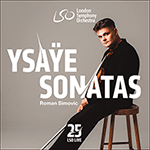
Welcome to Hyperion Records, a British classical label devoted to presenting high-quality recordings of music of all styles and from all periods from the twelfth century to the twenty-first.
Hyperion offers both CDs, and downloads in a number of formats. The site is also available in several languages.
Please use the dropdown buttons to set your preferred options, or use the checkbox to accept the defaults.
Although Enescu’s early compositions owed much to Romanian folk music, as a violinist he espoused not only Bach but also modern composers. Ysaÿe’s one-movement sonata, subtitled ‘Ballade’, also balances traditional tonal passages against ones that embrace the melodic and rhythmic wildness of central European folk song. After two introductory passages—a recitative and a passage largely in sixths—we hear the main theme, built on a dotted rhythm in major thirds. Surprisingly, the work becomes not less but more concordant towards the end, where D minor rules unmistakably for the last 75 seconds or so.
from notes by Roger Nichols © 2015
Si les premières compositions d’Enesco doivent beaucoup à la musique traditionnelle roumaine, le violoniste épousa non seulement la musique de Bach mais encore celle de compositeurs modernes. La sonate en un mouvement d’Ysaÿe, sous-titrée «Ballade», cultive également un juste équilibre entre des passages tonaux traditionnels et des passages qui intègrent l’extravagance mélodique et rythmique du chant traditionnel d’Europe centrale. Après deux passages d’introduction—un récitatif et une section principalement en sixtes—, arrive le thème principal, construit sur un rythme pointé en tierces majeures. Ce qui est étonnant, c’est que l’œuvre ne devient pas moins concordante, au contraire, vers la fin où ré mineur règne indubitablement pendant les soixante-quinze dernières secondes.
extrait des notes rédigées par Roger Nichols © 2015
Français: Marie-Stella Pâris
Obwohl Enescus frühe Kompositionen sehr an der rumänischen Volksmusik orientiert sind, setzte er sich als Geiger nicht nur besonders für Bach, sondern auch für moderne Komponisten ein. Ysaÿes einsätzige Sonate mit dem Untertitel „Ballade“ hält ebenfalls traditionelle tonale Passagen sowie solche, die sich die melodische und rhythmische Wildheit des mitteleuropäischen Volksliedrepertoires zu eigen machen, im Gleichgewicht. Nach zwei einleitenden Passagen—ein Rezitativ und eine hauptsächlich in Sexten gehaltene Passage—ist das Hauptthema zu hören, dem ein punktierter Rhythmus mit großen Terzen zugrunde liegt. Überraschenderweise wird das Werk gegen Ende nicht weniger, sondern zunehmend konkordant: d-Moll herrscht in den letzten, schätzungsweise 75 Sekunden vor.
aus dem Begleittext von Roger Nichols © 2015
Deutsch: Viola Scheffel
 Ysaÿe: Sonatas for solo violin Ysaÿe: Sonatas for solo violinWritten in 1923, Eugène Ysaÿe’s sonatas represent a musical snapshot of a particularly rich moment in the evolution of violin playing. An acclaimed violinist himself, each of the sonatas was written for one of Ysaÿe’s contemporaries: Joseph Sziget ...» More |
 Ysaÿe: Sonatas for solo violin Ysaÿe: Sonatas for solo violinTreading confidently in the footsteps of her award-winning Bach Sonatas & Partitas for solo violin, Alina Ibragimova brings to Ysaÿe’s twentieth-century response to these seminal works astonishing tenderness and strident vigour in equal measure.» More |

